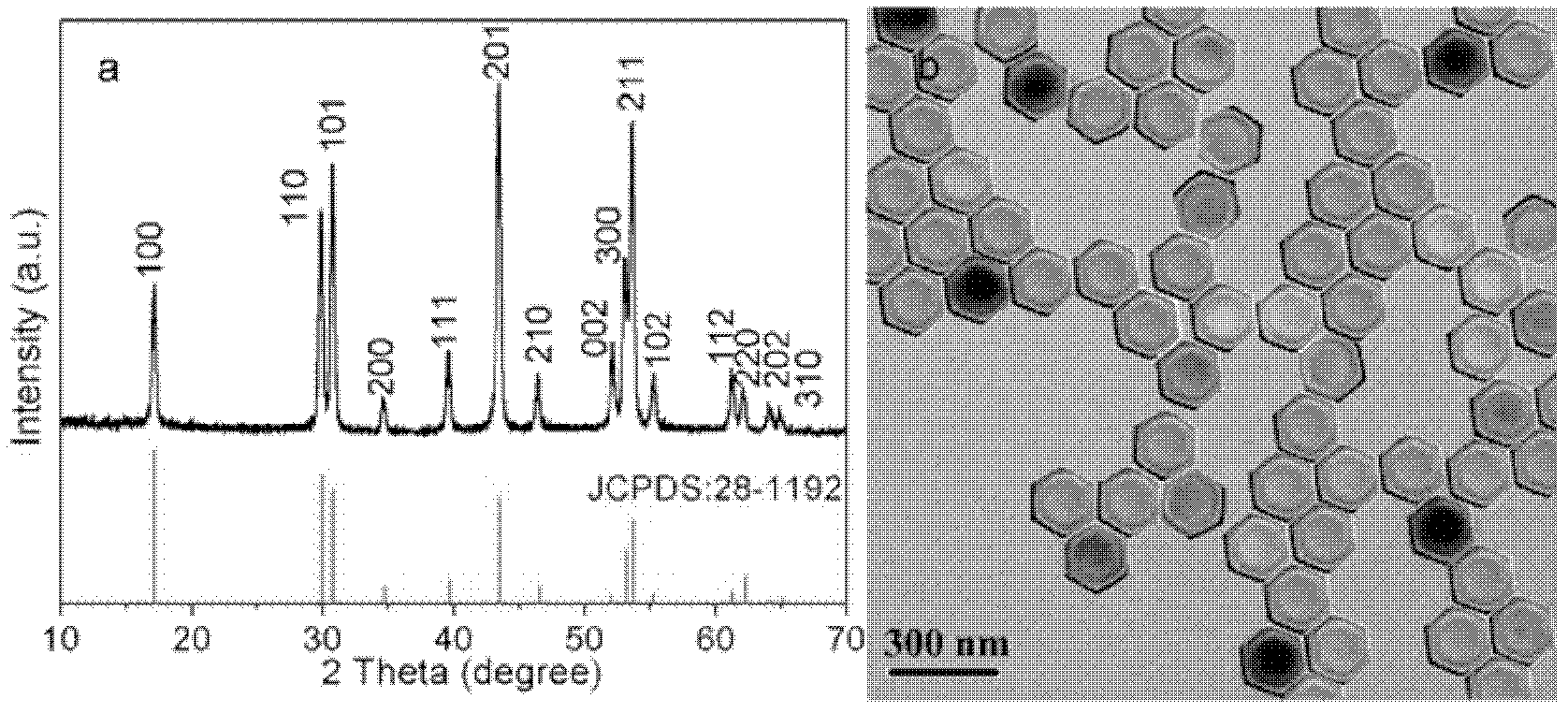Bioluminescent nanoparticle with 800-nanometer strong near infrared up-conversion emission characteristic and application thereof
A technology with infrared up-conversion and emission characteristics, applied in the field of biofluorescent marker preparation and application, can solve the problems of limited application and long-term observation, and achieve the effect of high penetration ability
- Summary
- Abstract
- Description
- Claims
- Application Information
AI Technical Summary
Problems solved by technology
Method used
Image
Examples
Embodiment 1
[0032] Mix 40ml of oleic acid, 20ml of alcohol, and 16ml of water evenly, add 2.4g of NaOH under stirring to form a uniform milky white colloid, then add 1mmol of mixed rare earth compound aqueous solution (the mole percentage of rare earth ions is Yb(NO 3 ) 3 :20%; Tm(NO 3 ) 3 :0.5%; Y(NO 3 ) 3 :79.5% and Yb(NO 3 ) 3 :20%; Tm(NO 3 ) 3 :0.5%; Ho(NO 3 ) 3 :2%; Y(NO 3 ) 3 : 77.5%). Then, under rapid stirring, 8mmol NaF aqueous solution was added dropwise to form a uniform emulsion, and then transferred to the reaction kettle at 180°C for 19 hours. After the reaction is over, cool to room temperature naturally, take out the reaction solution and centrifuge it, pour it out, wash it with alcohol and deionized water and centrifuge it 3 times, and then dry it in a vacuum drying oven at 80°C to obtain NaYF 4 : Yb / Ho / Tm nano-single crystal, hexagonal plate with a side length of 130nm, its structure and morphology are as follows figure 1 As shown in the XRD and SEM photos. Pumped with a 9...
Embodiment 2
[0034] Add 1mmol of rare earth chloride salt LnCl 3 ·6H 2 O (Ln = 70% Lu, 18% Yb, 10% Ho, 2% Tm), 15 mL ODE (octadecene), 6 mL OA are placed in a 100 mL three-necked flask, and the system is elevated under the protection of argon And react for 30 min at 160℃, then cool the temperature of the system to room temperature, add 4mmol (0.148g) ammonium fluoride and 2.5mmol (0.1g) sodium hydroxide dissolved in 10mL of anhydrous methanol slowly dropwise Put it into a three-necked flask and keep stirring at room temperature for 60 minutes, then raise the temperature of the system to 50°C to remove the methanol solution in the reaction mixture, continue to rapidly increase the temperature to 300°C under the condition of passing protective gas, and keep it for 60 minutes, then stop heating. After the reaction system is naturally cooled to room temperature, an excess amount of absolute ethanol is used to precipitate the product, and a mixed solution of absolute ethanol, cyclohexane, and de...
Embodiment 3
[0036] At 40℃, the YbCl 3 : 4%; TmCl 3 :0.5%; YCl 3 : 95.5% and YbCl 3 : 4%; TmCl 3 : 0.5%; HoCl 3 :2%; YCl 3 : 93.5% were mixed uniformly, and stirred into a uniform transparent chloride solution. Then, urea was added to adjust the pH value, and precipitation occurred in the solution, and the temperature was raised to 80°C to complete the precipitation. Separate the precipitate with a centrifuge and rinse with deionized water repeatedly. The washed precipitate is dried and placed in a muffle furnace, slowly heated to 500°C, kept at a constant temperature for 3 hours, and cooled to room temperature. Then the cooled product is annealed at 800°C to obtain the required rare earth-doped single crystal sample Y 2 O 3 :Yb / Ho / Tm and Y 2 O3:Yb / Tm, the size of single crystal sample is about 200nm. Pumped with a 980nm laser, in Y doped with holmium ions 2 O 3 In the sample, the luminescence intensity near 800nm of thulium ion is significantly improved compared with the luminescence in...
PUM
 Login to View More
Login to View More Abstract
Description
Claims
Application Information
 Login to View More
Login to View More - R&D
- Intellectual Property
- Life Sciences
- Materials
- Tech Scout
- Unparalleled Data Quality
- Higher Quality Content
- 60% Fewer Hallucinations
Browse by: Latest US Patents, China's latest patents, Technical Efficacy Thesaurus, Application Domain, Technology Topic, Popular Technical Reports.
© 2025 PatSnap. All rights reserved.Legal|Privacy policy|Modern Slavery Act Transparency Statement|Sitemap|About US| Contact US: help@patsnap.com



